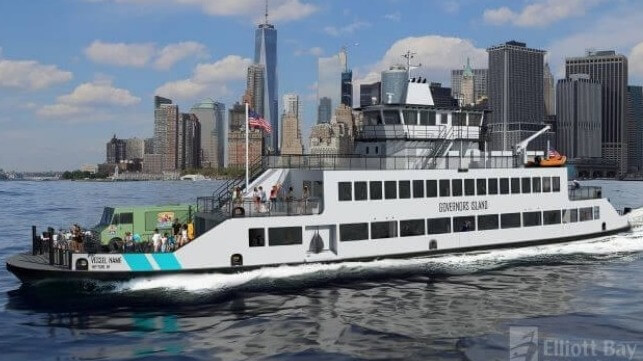New York City to Commission its First Hybrid, Electric Ferry in 2024

New York City is joining the growing list of operators of hybrid-electric ferries as it ordered its first vessel for public operation in New York harbor. The City’s Mayor Eric Adams announced yesterday, March 29, that a contract has been awarded for the construction of the first public, hybrid-electric ferry for the city. They expect the vessel to begin transporting tourists from Lower Manhattan to Governors Island in the summer of 2024.
The first vessel of its kind to provide public transportation within New York Harbor, the new ferry will be equipped with a hybrid propulsion system that will reduce air pollution by allowing it to toggle between zero-emission battery-only power and battery-assisted hybrid with diesel backup. It will have a capacity for up to 1,200 passengers and will have a cruising speed of 10 knots. The passenger amenities will include a lower-level ADA-accessible lounge and restrooms on each level.
The ferry was designed for New York City by the Elliott Bay Design Group, which previously worked with New York City on the design and construction of three new ferries operating to Staten Island. In a 2021 request for proposals, the vessel was described as being 190 feet in length, doubled-ended with the ability to transport both vehicles and passengers. battery hybrid diesel-electric propulsion system. Propulsion was described as a two variable?speed, reversing permanent magnet motors rated for 540 kW at 670 rpm with one propeller at each end of the vessel.
“As New Yorkers transition to greener forms of transportation, the city and our partners are leading the way with cleaner, more efficient ways to go just about anywhere,” said Mayor Adams. “The next generation deserves a green city and a vibrant Governors Island, and this first-of-its-kind ferry will help us deliver both.”
The ferry will have the ability to operate either fully on battery power or in dual-power mode. The battery-assist mode will allow the new ferry to reduce carbon dioxide emissions by approximately 600 tons annually. Future plans for rapid vessel charging installation will enable the ferry to operate with zero-emission battery-only propulsion, at which point emissions will drop to nearly zero.
“Ferries are a vital part of transportation infrastructure, lasting 40 to 60 years or more said John W. Waterhouse, principal in charge of Elliott Bay Design Group. “We work closely with our clients and their teams to ensure the vessel is fit for purpose and engineered to match a long life.”
The new ferry will replace the diesel-powered Lt. Samuel S. Coursen, which is currently operated by the Trust for Governors Island. The current vehicle and passenger ferry was commissioned by the U.S. Army in 1956 and has been in continuous use since.
The construction contract for the Conard Shipyard’s facility in Morgan City, Louisiana. During the announcement, the city said the ferry is under construction with delivery due by mid-2024. The ferry will be operated by the Trust for Governors Island on trips that last for about 15 minutes between Manhattan and the island.
As part of the announcement of the ferry, New York City and the Trust also began a citywide competition to name the new vessel. New Yorkers are invited to suggest names for the vessel.

that matters most
Get the latest maritime news delivered to your inbox daily.
“This hybrid ferry marks a historic step forward in expanding access to Governors Island while promoting state-of-the-art and sustainable technology to power our ferry fleet,” said Trust for Governors Island President and CEO Newman. “Each year, hundreds of thousands of visitors board our vessels and journey to Governors Island to experience our rich recreational, cultural, and educational resources. We are thrilled to make the journey easier for our visitors while helping to lead the charge in electrifying the vessels of New York Harbor.”
A historical part of New York Harbor, the island was used by the U.S. Army, and in 1966, the Island was transferred to the United States Coast Guard. It became the Coast Guard's largest installation with over 3,000 people living on the island at its peak. The Coast Guard closed its base in September 1996 and in the early 2000s a portion of the island became a national park. The remaining 150 acres were sold to New York State 20 years ago and became a public park.
